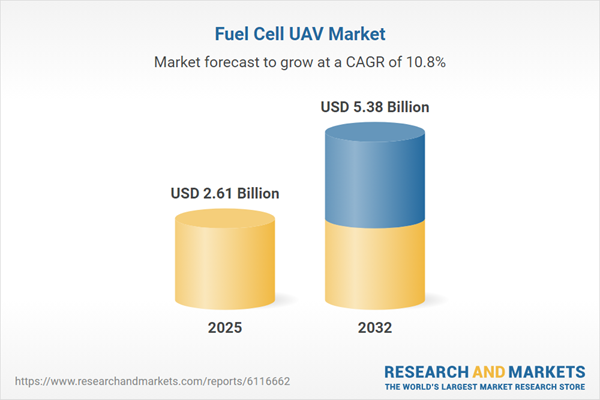Speak directly to the analyst to clarify any post sales queries you may have.
The fuel cell UAV market is witnessing robust advancements, driven by increasing demand for sustainable propulsion in unmanned aerial vehicle operations. This transformation is fueled by technological innovation and strategic investment, positioning hydrogen-powered UAVs as critical assets for diverse industries seeking improved endurance and reduced environmental impact.
Market Snapshot: Fuel Cell UAV Market Growth and Trends
The Fuel Cell UAV Market grew from USD 2.36 billion in 2024 to USD 2.61 billion in 2025. It is expected to continue growing at a CAGR of 10.81%, reaching USD 5.38 billion by 2032. This upward trajectory is rooted in increasing adoption of hydrogen fuel cell propulsion across sectors such as logistics, environmental monitoring, and defense. Ongoing government incentives and tightening emissions regulations are accelerating investment, with stakeholders focusing on enhancing system efficiency and sustainability to address evolving operational and environmental mandates.
Scope & Segmentation
- Fuel Cell Type: Alkaline, Molten Carbonate, Phosphoric Acid, Proton Exchange Membrane, Solid Oxide
- UAV Type: Fixed Wing, Hybrid VTOL, Rotary Wing
- Power Output: 5-20 kW, <5 kW, >20 kW
- Application: Commercial Delivery, Medical Supply Transport, Environmental Monitoring, Pipeline Inspection, Powerline Inspection, Agricultural Surveying, Geological Survey, Infrastructure Mapping, Academic Research, Industrial R&D, Battlefield Monitoring, Border Patrol, Maritime Surveillance
- End User: Agriculture, Civil & Government, Commercial, Environmental, Military & Defense
- Region: Americas (United States, Canada, Mexico, Brazil, Argentina, Chile, Colombia, Peru), Europe, Middle East & Africa (United Kingdom, Germany, France, Russia, Italy, Spain, Netherlands, Sweden, Poland, Switzerland, United Arab Emirates, Saudi Arabia, Qatar, Turkey, Israel, South Africa, Nigeria, Egypt, Kenya), Asia-Pacific (China, India, Japan, Australia, South Korea, Indonesia, Thailand, Malaysia, Singapore, Taiwan)
- Companies Covered: AeroVironment, Ballard Power Systems, Horizon Fuel Cell Technologies, SFC Energy, EaglePicher Technologies, Intelligent Energy, ZeroAvia, AFC Energy, Plug Power, Hevendrones, Toshiba Energy Systems & Solutions, SKYCORP Technologies, Sion Power Corporation, ISS Group, Insitu by Boeing, H3 Dynamics Holdings, Elbit Systems, Doosan Corporation, Barnard Microsystems, Alpha Unmanned Systems
Key Takeaways for Senior Decision-Makers
- Hydrogen fuel cell UAVs deliver greater endurance and payload capacity compared to conventional powertrains, reflecting rapid progress in catalyst and membrane technologies.
- Lifecycle sustainability is now central in procurement, requiring quantified assessment of emissions from supply to end-of-life as end users prioritize low-carbon performance.
- Collaborations between technology providers, system integrators, and end users are accelerating validation and field deployment of new UAV designs, especially in complex operational environments.
- Investment in advanced fuel cell chemistries and hydrogen storage solutions is fostering market readiness, while demonstration projects are refining safety and certification processes.
- Regional initiatives differ in pace and focus, with North America advancing defense and logistics, Europe spearheading clean infrastructure pilots, and Asia-Pacific concentrating on rapid technology scaling and refueling protocols.
Tariff Impact and Supply Chain Adaptation
The market is adjusting to new United States tariffs on imported fuel cell UAV components, which has driven manufacturers to prioritize supply chain resilience. Strategic shifts include increased localization, closer collaboration with domestic suppliers, and adoption of digital traceability systems to mitigate cross-border risks. These developments support industry adaptation and strengthen long-term competitiveness amidst changing trade dynamics.
Methodology & Data Sources
This report integrates in-depth interviews with UAV manufacturers, fuel cell technology developers, hydrogen suppliers, and end users, alongside extensive secondary research from scientific journals, whitepapers, and regulatory documents. Analytical rigor is maintained through cross-validation, benchmarking, and supply chain mapping, ensuring the accuracy and relevance of market insights for technology and business leaders.
Why This Report Matters
- Enables senior executives to benchmark technology, policy, and supply chain shifts across all major verticals and regions.
- Supports the development of actionable strategies for investment prioritization, ecosystem partnerships, and scalable platform deployment in the fuel cell UAV space.
Conclusion
With the growing emphasis on sustainable and resilient UAV operations, fuel cell-powered platforms are emerging as key enablers of operational excellence. This report equips decision-makers with actionable insights to capture evolving opportunities and effectively navigate industry transformation.
Table of Contents
3. Executive Summary
4. Market Overview
7. Cumulative Impact of Artificial Intelligence 2025
Companies Mentioned
The companies profiled in this Fuel Cell UAV market report include:- AeroVironment, Inc.
- Ballard Power Systems Inc.
- Horizon Fuel Cell Technologies Pte Ltd
- SFC Energy AG
- EaglePicher Technologies, LLC
- Intelligent Energy Limited
- ZeroAvia Inc.
- AFC Energy PLC
- Plug Power Inc.
- Hevendrones Ltd.
- Toshiba Energy Systems & Solutions Corporation
- SKYCORP Technologies.
- Sion Power Corporation.
- ISS Group Ltd.
- Insitu by Boeing Company
- H3 Dynamics Holdings Pte. Ltd.
- Elbit Systems Ltd.
- Doosan Corporation
- Barnard Microsystems Ltd.
- Alpha Unmanned Systems, SL
Table Information
| Report Attribute | Details |
|---|---|
| No. of Pages | 197 |
| Published | November 2025 |
| Forecast Period | 2025 - 2032 |
| Estimated Market Value ( USD | $ 2.61 Billion |
| Forecasted Market Value ( USD | $ 5.38 Billion |
| Compound Annual Growth Rate | 10.8% |
| Regions Covered | Global |
| No. of Companies Mentioned | 21 |









